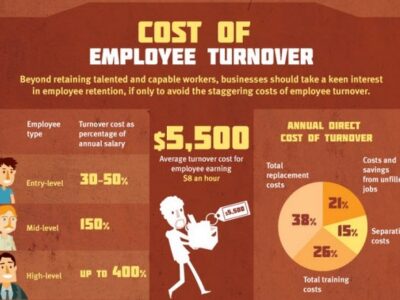You can’t have a successful business without a dedicated group of employees, and that means not just hiring qualified employees but keeping them as well. Employee retention strategies are crucial for any business that wants to excel in 2025.
We discussed employee retention in-depth during our podcast episode, Employee Retention, with Sandra Kearney of Human Power Solutions. She highlighted the importance of keeping employees and maintaining low turnover, saying:
“It’s really expensive to find, recruit, and train an employee, and then have them leave after a year. When an employee leaves like that, it creates a void in whatever they were doing — whether they were sweeping the floors or running the finances.”
Though preventing turnover often feels like an almost impossible task, the right strategies for employee retention can help you keep your best employees around for years to come. So let’s dive deeper and take a closer look at workforce retention ideas you can implement in 2025.
What is Employee Retention and Why Does it Matter?
Let’s start at square one—what is employee retention? Retention is a simple concept, and it can be defined as an organization’s ability to keep and retain its employees. Essentially, it’s a measure of how long employees stay at a company.
Retention is closely tied to turnover. They are inversely related, meaning lower turnover equals higher retention and vice versa. That said, it’s important to remember that these two are separate things even though they are correlated.
So what’s the importance of employee retention, and why does it matter? As Kearney pointed out in the quote above, low retention and high turnover is costly. Training employees takes time and money, plus they create a void until that position is filled.
Low retention also limits your teams’ ability to do their best. Teams are most effective when they have built bonds and know each other’s strengths and weaknesses, which only happens when they have time to develop together as a team.
How to Calculate Employee Retention Rate
Before we move onto employee retention strategies, let’s quickly look at how to calculate employee retention rate. You don’t know if your retention rate is good or not until you actually calculate it, so the formula is essential knowledge for managers and leaders.
Thankfully, the formula for worker retention is fairly simple:
Retention rate = (number of employees at the start / number of employees at the end) X 100.
You can set your time period to whatever you want, though checking your rate for the year is a good starting point. So say you started with 200 employees and ended with 180. That means your retention rate would be 90%, which is considered a good retention rate.
Employee Retention Strategies
Now it’s time to look at some employee retention ideas and the best practices for keeping employee retention high. By utilizing the strategies listed below, you can keep your retention high and build high-performing teams.
Perfect Your Recruitment Process
One of the best employee retention strategies is to refine your recruitment process. If you can avoid hiring employees who will later leave, you can deal with retention issues before they arise.
For example, market the job accurately. Many employers are misleading with their job listings, resulting in employees who feel deceived after they take the job—making them more likely to leave.
Another workforce retention strategy is to manage expectations and know what kind of culture you have. Finding employees that fit with your company culture can greatly reduce turnover. Kearney mentioned this during our conversation when she said:
“I think people have to look at what kind of culture feeds them. If they’re a work hard culture, they want to know exactly what [they’re] going to be doing every single day. Ask around Glassdoor, and check the reviews of the company before you go. Go on LinkedIn to connect with people that are actually working at the company you’re looking at, and see if you can connect with them.”
Offer Fair Compensation
Compensation is another factor very important to retention. Fair compensation can keep employees around, while poor compensation can encourage them to look for a better opportunity elsewhere. Studies back this up as well.
According to a Harvard Business review report, 62% of low wage workers say they’d be motivated to stay with their job if offered higher pay or a promotion. And according to an SHRM study, 74% of HR professionals cited compensation as the number one reason for turnover.
Those stats show a very clear and direct correlation between compensation and retention. If employees are not having their financial needs met, they will look elsewhere for better paying positions.
Also, compensation is about more than pay. It also includes things such as benefits, and a good benefits package can also be a strong motivator to stay with a company. Employers should ensure they’re offering fair compensation all around, both financially and in terms of benefits.
Emphasize Employee Recognition
Employee recognition is often overlooked among employee retention strategies, but it can be incredibly effective. As humans we want to be recognized for our efforts. Employees who feel appreciated are much less likely to look for other jobs and leave.
A great way of encouraging more recognition is via a company news channel that focuses on good news. Kearney explained this in our conversation, explaining:
“The good news channel is really so that managers and employees can get some ‘atta boys!’ to people across the organization. So you know if someone lands a deal or if someone, you know it gets great customer service feedback, whatever—it goes in the good news channel. So you’re filling your airwaves with all the good that’s going on in the company, and that makes people feel good.”
For more individualized recognition, you could consider our employee recognition survey to learn how your employees like to be appreciated. Employee retention incentives can also be tied in with recognition, furthering your efforts to bolster retention.
Create a Sense of Community
A good sense of community is important for every business, but it’s especially important when talking about retention. Having a welcoming and supportive company culture with inclusive leaders can go a long way in making people feel more comfortable, increasing retention.
A simple way to start creating a sense of community is with more casual conversations. Kearney noted the importance of keeping in touch and even provided an example during the podcast:
“Opening up a lunch channel and saying, ‘Hey, between 12:00 and 1:30 this channel is going to be open for lunch.’ So anyone that’s having lunch that wants to kind of sit around and kind of gab can come on in. It’s the community, right? So we’re talking about community, and then we talk about creating wellness challenges, keeping in touch with people, making sure that we’re recognizing some signs of people that are not engaged, and we help managers kind of see into what’s going on.”
Team building is also one of the most fun employee retention ideas. Our events and other similar team bonding events are a fun and effective way to build bonds and foster a stronger, more connected sense of community in the workplace.
Offer Room for Growth
Employees don’t like feeling stuck. If they don’t have opportunities to grow, learn new skills, and get promotions, they will likely look for those things elsewhere. That makes providing room for growth one of the best employee retention strategies out there.
Provide career advancement opportunities, encourage professional development, help employees improve adaptive skills, promote from within, and offer incentives. All of those will help with staff retention.
Promote a Work-Life Balance
Every year employees place more importance on work-life balance, and businesses that don’t adjust to meet those expectations will likely deal with poor retention rates as a result. Support work-life balance and make your organization somewhere employees want to work.
Allow for hybrid and remote work when possible, offer flexible hours, and don’t micromanage. Give employees the freedom and balance they want, and they will reward you with loyalty and hard work.
At the end of the day, work-life balance really comes down to listening to your employees and their needs. Practice effective communication and do your best to provide employees a healthy work-life balance.
Master Change Management
Another effective tip is to make your workplace culture one of adaptability to continuous change. Embracing change and mastering change management can help you and your employees more effectively deal with change, encouraging higher retention.
A supporting environment that promotes continuous learning and embraces changes means employees will feel comfortable growing and trying new things, resulting in higher engagement, motivation, and most importantly, retention.
While it’s not one of the most obvious ideas for employee retention, change management can have a big impact. Our Change Management Training is a great way to start leaning into change and using it to your advantage.
Retain Employees with TeamBonding
Retention rates are a reflection of company culture. Companies with a positive culture that provide fair compensation, a healthy work-life balance, and offer room for growth rarely have retention issues, and those that don’t typically struggle keeping employees around.
If you want to continue your success into 2025, employee retention strategies are key. Businesses should focus on meeting the needs of their employees and creating a workplace that employees want to be in.
Team building can be an incredibly effective retention strategy, and at TeamBonding, we have all the knowledge and experience necessary to boost retention rates with our team building activities. So get in touch with us and start prioritizing retention with TeamBonding.













